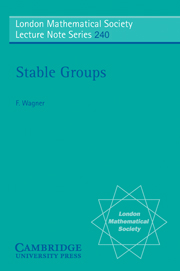5 - Groups & Grades
Published online by Cambridge University Press: 05 April 2013
Summary
In this chapter we shall analyse stable groups with the additional property ℜ, a property common to small stable and superstable groups. We shall define it in section 0 and show that a small stable group is ℜ; the proof also implies that the index of the image of an endomorphism of a small group is at most the cardinality of the kernel (as long as both are finite). We then derive some immediate consequences like the independence of the generic type of the group law. In section 1 we shall prove that an infinite ℜ-group must always contain an infinite abelian subgroup, and look at ℜ-fields: an ℜ-ring without zero-divisors is a commutative, algebraically closed field, and any definable automorphism is ∅-definable and has finite fixed field.
In section 2 we shall prove an analysability result reminiscent of Remark 3.6.2, replacing regular types by abelian subgroups. In particular there exist abelian subgroups which are big, i.e. not co-foreign to the generic type of the whole group.
The next section deals with linear operations and the existence of definable fields. The problem here is one of comparing groups: if G operates on A as a group of automorphisms, in order to obtain a field, we have to take care that the sums Σi(giA) remain bounded, for elements gi from G. In a certain way this means that A and G have comparable size; technically it is achieved by requiring A to be G-minimal and gen (A) not to be foreign to G.
- Type
- Chapter
- Information
- Stable Groups , pp. 250 - 293Publisher: Cambridge University PressPrint publication year: 1997
- 1
- Cited by



